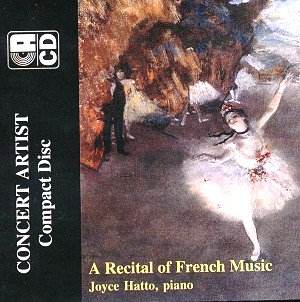AVAILABILITY
www.concertartistrecordings.com
I know that Joyce Hatto spent some productive
time in the company of Alfred Cortot, in much the same way as
she had with Moiseiwitsch. Doubtless she absorbed much from these
two masters. This latest Concert Artist disc bears all the hallmarks
of the Frenchmanís kind of repertoire as it does Hattoís characteristic
embodiment of tradition and modernity. Each time I sit down to
a Hatto review I find myself commenting on the pellucid clarity
of her passagework and her eloquent and undimmed technique. I
do this again, without embarrassment, not simply because itís
true but because it says something about her directness and honesty
as a musician, her way of putting the composer above questions
of the projection of the self. The precision of her touch is notable
as well, as is her abstention from overuse of the pedal. All of
these qualities inform her playing on this disc and I hope readers
will forgive me contrasting her Franck playing with those two
titans of yesteryear, Cortot (of course) and Petri. Egon Petriís
American Columbia recording of the Prélude, choral et fugue
is a particular favourite of mine (though not everyone shares
my admiration).
In the Prélude Hatto takes a view almost
equidistant between Cortotís impetuous and multiply voiced passion
and Petriís absolute control. I say almost but she does
rather incline to Petriís kind of clarity and explication rather
than Cortotís surging emotionalism. In the choral one notices
how Hatto holds back slightly, generating feeling through clarity,
though I wonder about some of her rubati here. I suspect that
she is injecting a note of doubt into the Gothic splendour Ė whereas
Petri concentrates on architectural span and Cortot once more
on colour and voicings and great drama. The fugue witnesses her
outstanding clarity of entry points and considerable sheer excitement
Ė the concluding peals are splendid. Cortot is more tensile and
obviously affecting whilst Petri finds in the music something
I think Hatto hints at in the choral, which is a brusque, unsettled
and almost neurotic sound-world in which the concluding peals
are ones of struggle overcome and not joyful, cyclic recognition.
All these points of view mark independent and authoritative visions
of the work.
The Prélude, aria et final dates from
that annus mirabilis for Franck, 1886, in which year the Violin
Sonata was written. Contrasting Hatto and Cortot here (Petri never
recorded it as far as I know) one finds that she sounds rather
plain in her opening statements but one notes further that she
relies on tonal subtlety not great dynamic range to make her points.
Maybe by the side of an oratorical performer such as Cortot she
seems to lack fantasy and his brand of heart-stopping grandeur
(one to which I repeatedly succumb) but her aria is attractively
chaste at the same basic tempo as Cortotís, though his rhetoric
is rather darker and more incisive than hers. I liked Hattoís
taut finale; Cortot is capricious here, daring and theatrical,
Hatto softer grained but very clear and managing expressive turns
on a sixpence before her leoninely powerful conclusion. If I incline
more to Cortotís performance one cannot deny Hattoís justness
of perception or her cast iron technical reserves.
She also plays a selection of Debussy Preludes
and convincingly so, of course. Thereís considerable chordal depth
in her La cathédrale engloutie whilst La danse
de Puck is fleet if less fantastical and glinting than
say Michelangeliís. Minstrels is fluid and nicely characterised
- Michelangeliís performance at the Vatican in 1972 was more visceral
and vertical Ė and La Puerta del vino is gently veiled.
Her Preludes are in general sensitive and attractively contoured
and the concluding Saint-Saëns is a marvellous, and rare,
opportunity to hear one of the seldom programmed Etudes. Cortot
apparently told Joyce Hatto that it was "elegant and discreet"
and she plays it with authoritative command and no little style.
Iíve greatly enjoyed this latest addition to
the Hatto discography. Itís full of character and dedicated musicality
and very attractively recorded as well.
Jonathan Woolf
see also JOYCE
HATTO - A Pianist of Extraordinary Personality and Promise:
Comment and Interview by Burnett James
Other
Concert Artist recordings
